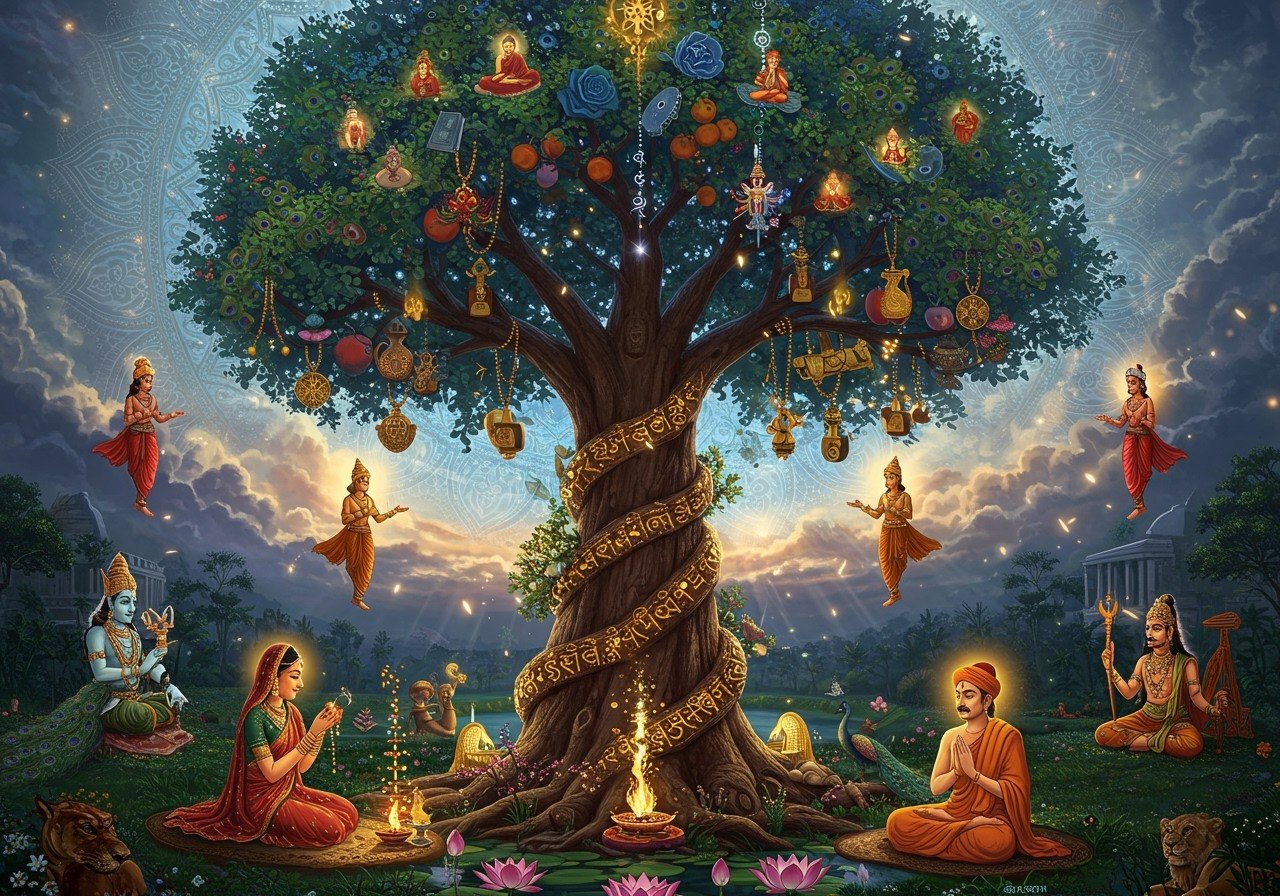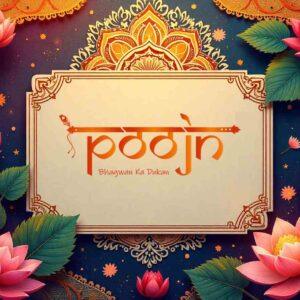
In the mystical world of Indian mythology, the Kalpavriksha stands tall as a symbol of life and abundance. Known to many as the wish-fulfilling divine tree, the Tree of Life holds a special place in our hearts, deeply rooted in tradition. This sacred tree has a rich history across various cultures and religions, offering profound insights into spiritual fulfillment and the promise of eternal life. Let’s delve into its significance and explore how it continues to resonate with those of us who value authentic ritual items.
Kalpavriksha in Hinduism
The Kalpavriksha finds its roots in Hindu mythology, revered as a divine tree brimming with blessings. It’s intrinsically linked to the Samudra Manthan, the epic churning of the cosmic ocean, from which it emerged as a potent symbol of prosperity and auspiciousness. Ancient texts like the Rigveda speak of this sacred tree, weaving it into the very fabric of Lord Krishna’s childhood stories. Here, the Kalpavriksha embodies the essence of eternal life and boundless abundance, bestowing its grace upon those who seek its blessings with a pure heart.
Looking to enhance your understanding of sacred symbols? Our blog post on Rudraksha and Tulsi offers a deeper dive into these powerful symbols.
Kalpavriksha in Jainism
In Jainism, the Kalpavriksha holds a unique and revered position. It transcends the form of an ordinary tree, becoming a celestial symbol residing in the sacred realm of the Tirthankaras, our enlightened spiritual teachers. The Kalpavriksha here represents spiritual abundance, a wellspring of wisdom and guidance for ascetics on their path to liberation. Unlike the pursuit of material wealth, it offers the true riches of spiritual fulfillment, nurturing the soul’s journey towards enlightenment. Jain scriptures highlight its benevolent presence as a provider, a theme echoed in ancient texts and artistic representations. You’ll often find the Kalpavriksha gracing the walls of Jain temples, a testament to its sacred role within our cosmology.
Kalpavriksha in Buddhism
Within Buddhism, the concept of the Tree of Life often intertwines with the sacred Bodhi Tree, under whose sheltering branches Buddha attained enlightenment. This tree stands as a powerful symbol of spiritual awakening and the profound interconnectedness of all beings. It reflects the cyclical nature of life, death, and rebirth, a continuous journey of transformation. Buddhist art frequently portrays the Bodhi Tree as an emblem of wisdom, serenity, and the path to inner peace. The very essence of Kalpavriksha resonates deeply within Buddhism, echoing the themes of growth, spiritual fulfillment, and the pursuit of enlightenment.
Kalpavriksha Across Other Cultures
The profound symbolism of a Tree of Life is a common thread woven through the tapestry of numerous cultures. In Norse mythology, Yggdrasil serves as a bridge between different realms, much like Kalpavriksha’s connection to prosperity. Christianity places the Tree of Life in the Garden of Eden, reflecting themes of eternal life and divine presence. The Celtic tree forms a sacred link between the earth and the heavens, symbolizing ancestry, spirituality, and the continuity of life. Across these diverse cultures, these trees embody fundamental concepts of life, knowledge, and renewal. They share universal themes that may have intertwined and evolved through cultural exchanges over centuries.
Kalpavriksha in Modern Context
Even in today’s fast-paced world, the Kalpavriksha continues to hold deep relevance within Indian society. It graces our art, literature, and cultural expressions, serving as a powerful symbol of tradition and spirituality. Numerous festivals celebrate its enduring legacy, incorporating it as a central motif in rituals and celebrations. The convenience of online platforms now grants easy access to ritual items associated with Kalpavriksha, beautifully blending tradition with modern accessibility. This ensures the tree’s significance endures, connecting us to our cultural roots while seamlessly adapting to contemporary lifestyles.
Kalpavriksha in Hindi Literature and Language
Kalpavriksha finds rich expression in Hindi literature and the vibrant tapestry of folklore. It often serves as a potent metaphor in idioms and phrases, highlighting its deep cultural significance. Regional languages across India embrace its myths and legends, weaving them into the fabric of local traditions. Notable Hindi literary works feature the Tree of Life prominently, exploring its philosophical implications and timeless wisdom. This continued literary presence ensures the Kalpavriksha remains alive and flourishing in our collective cultural consciousness, passed down through generations as a symbol of hope and abundance.
How Poojn.in Helps You Connect with Kalpavriksha Traditions
At Poojn.in, we understand the deep significance of the Kalpavriksha. We offer a thoughtfully curated selection of essential items needed for Kalpavriksha-related rituals and worship across diverse cultural traditions. Explore our collection:
Sacred Plants and Materials:
- Tulsi plants and saplings: Bring the sanctity of Tulsi into your home garden with our healthy, vibrant plants. Cultivate your own sacred space and connect with this revered plant.
- Pure copper planters and vessels: Enhance your rituals with our elegant and durable copper planters and vessels. Honor tradition while adding a touch of beauty to your sacred space.
- Traditional watering vessels: Perform your plant care rituals with authentic watering vessels, adding a deeper layer of meaning to your daily practices.
Need high-quality threads for your rituals? Explore our selection:
- Cotton Thread (Red, White, Yellow, Black – 445 Thread)
- Cotton Thread (Red, White, Yellow, Black – 555 Thread)
Worship Items:
- Complete puja thalis for tree worship: Simplify your ceremonies with our comprehensive puja thalis, containing all the essential items for a reverent and traditional worship experience.
- Pure ghee diya sets for aarti: Illuminate your sacred space with the warm glow of pure ghee diyas, creating an atmosphere of devotion and reverence.
- Organic incense and dhoop for rituals: Elevate your rituals with the fragrant offerings of organic incense and dhoop, creating a serene and spiritually uplifting ambiance.
- Specialized Kalpavriksha yantra and mantra cards: Deepen your connection to the Kalpavriksha with our authentic yantras and mantra cards, offering guidance and support on your spiritual journey.
Educational Resources:
- Detailed guides on plant care: Learn the proper methods for nurturing and caring for your sacred plants, ensuring their health and longevity.
- Instructions for tree worship ceremonies: Gain a deeper understanding of traditional tree worship ceremonies with our easy-to-follow instructions, allowing you to perform rituals with confidence and reverence.
- Authentic mantras and their meanings: Discover the power and significance of authentic mantras, enriching your spiritual practice and understanding.
To order these items or seek expert guidance on Kalpavriksha rituals, you can:
- Visit: www.poojn.in
- Call: 03369029784
- WhatsApp: 9476142738
Our team of knowledgeable pandits and experts are readily available to answer your questions about proper ritual procedures and item selection. We offer pan-India delivery with secure packaging to ensure your sacred items reach you safely and in pristine condition. All products come with quality assurance and authenticity certificates. Poojn.in maintains strict quality control to provide only the purest and most authentic items for your spiritual needs. [Note: Product availability may vary. Please check the website or contact us for current stock status.]
The Timeless Essence of Kalpavriksha
The Kalpavriksha, the revered Tree of Life, stands as a timeless symbol of spiritual and cultural richness. Across diverse religions and cultures, it transcends the form of a mere mythical tree, embodying the very ideals of growth, wisdom, and the profound connection that unites all beings. In Jainism, it serves as a beacon of spiritual abundance, guiding seekers on their path to liberation. In Buddhism, it resonates deeply with the concepts of enlightenment, rebirth, and the continuous cycle of existence. Other cultures, too, find their own unique reflections within this ancient and powerful symbol.
In today’s interconnected world, the Kalpavriksha remains a source of inspiration, bridging the wisdom of the past with the realities of the present. It graces our literature, festivals, and rituals, serving as a constant reminder of our rich and vibrant heritage. With online platforms like poojn.in bringing ritual items directly to our doorsteps, honoring these traditions has become more accessible than ever before. Kalpavriksha’s enduring presence in our lives strengthens our connection to our roots, offering a profound sense of belonging and continuity.
As we celebrate this sacred symbol, let us cherish its power to unite us across time and space. The Kalpavriksha inspires us to seek knowledge, embrace personal growth, and nurture the precious bonds we share with each other and the universe. Let us find solace and strength in its timeless wisdom.
FAQs on Kalpavriksha Across Cultures and Religions: The Tree of Life Explored
What is Kalpavriksha? Kalpavriksha, often referred to as the Tree of Life, is a mythical tree deeply rooted in the traditions of various cultures and religions. It is believed to grant wishes and stands as a divine symbol of abundance and prosperity.
How is Kalpavriksha significant in Jainism? In Jainism, Kalpavriksha holds a special place as a wish-fulfilling tree believed to have provided for all desires in the early periods of the world. It symbolizes not only material prosperity but also spiritual fulfillment and the attainment of liberation.
What role does the Jain Kalpavriksha play in religious rituals? The Jain Kalpavriksha holds a symbolic role in rituals, representing the divine capacity to fulfill wishes and underscoring the importance of prioritizing spiritual growth over material desires. It serves as a reminder of the true source of abundance and the path to enlightenment.
Where can I find references to Kalpavriksha in Hindi literature? You can find numerous references to Kalpavriksha within ancient Hindi texts and scriptures. These often describe its divine attributes, its significance in spiritual narratives, and its role as a symbol of hope and abundance.
Why is Kalpavriksha called the Tree of Life? The name “Tree of Life” is bestowed upon Kalpavriksha because it embodies the essence of eternal life, nourishment, and the fulfillment of desires across various cultures. It symbolizes the interconnectedness of all life and the boundless potential for spiritual abundance. It’s a powerful reminder of the life-giving force that sustains and nourishes us all.
What are some cultural beliefs associated with Kalpavriksha? Across different cultures, Kalpavriksha is associated with a variety of beliefs, including its power to grant wishes, provide eternal nourishment, and symbolize both material prosperity and profound spiritual wisdom. It’s seen as a source of blessings and a connection to the divine.
Is Kalpavriksha only significant in Indian religions? While Kalpavriksha holds great significance in Indian religions such as Hinduism, Buddhism, and Jainism, similar concepts exist in numerous other cultures around the world. These parallel concepts often involve trees or other natural elements that represent life, growth, abundance, and the interconnectedness of all beings. For instance, the Yggdrasil of Norse mythology and the Tree of Life in the Garden of Eden from the Christian tradition share similar themes of connection, sustenance, and the promise of eternal life.
Discover the architectural wonders and spiritual significance of Chhattisgarh’s temples by exploring our blog post dedicated to this topic.


